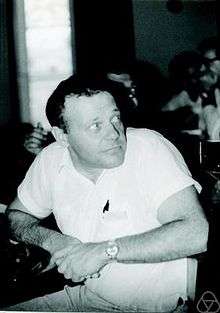Richard Kadison
| Richard Kadison | |
|---|---|
 | |
| Born |
July 25, 1925 New York City, New York, U.S. |
| Died | August 22, 2018 (aged 93) |
| Nationality | American |
| Alma mater | University of Chicago |
| Known for |
Kadison–Kaplansky conjecture Kadison's inequality Kadison–Singer problem[1] Kadison transitivity theorem Kadison–Sakai theorem Kadison–Kastler metric |
| Awards | Steele Prize (1999) |
| Scientific career | |
| Fields | Mathematics |
| Institutions | University of Pennsylvania |
| Doctoral advisor | Marshall Harvey Stone |
| Doctoral students |
James Glimm Richard Lashof Baruch Solel Erling Størmer Marc Rieffel |
Richard V. Kadison (July 25, 1925 – August 22, 2018)[2] was an American mathematician known for his contributions to the study of operator algebras.
Work
Born in New York City in 1925,[3][4] Kadison was a Gustave C. Kuemmerle Professor in the Department of Mathematics of the University of Pennsylvania.[5]
Kadison is a member of the U.S. National Academy of Sciences (elected in 1996),[6][7] and a foreign member of the Royal Danish Academy of Sciences and Letters[2] and of the Norwegian Academy of Science and Letters.[8] He is a 1969 Guggenheim Fellow.[9]
Kadison was awarded the 1999 Leroy P. Steele Prize for Lifetime Achievement by the American Mathematical Society.[5][10] In 2012 he became a fellow of the American Mathematical Society.[11]
Kadison was a skilled gymnast with a specialty in rings. He married Karen M. Holm on June 5, 1956, and they have one son, Lars.
Kadison died after a short illness on August 22, 2018.[3]
Selected publications
Books
- with John Ringrose: Fundamentals of the theory of operator algebras. 2 vols., Academic Press 1983; new edition, Fundamentals of the theory of operator algebras: Elementary theory, Vol. 1, 1997 Fundamentals of the theory of operator algebras: Advanced theory, Vol. 2, 1997 AMS 1997[12][13]
- with John Ringrose: Fundamentals of the theory of operator algebras, III-IV. An exercise approach, Birkhäuser, Basel, III: 1991, xiv+273 pp., ISBN 0-8176-3497-5; IV: 1992, xiv+586 pp., ISBN 0-8176-3498-3[14][15][16]
PNAS articles
- "On representations of finite type". Proc Natl Acad Sci U S A. 95: 13392–6. 1998. doi:10.1073/pnas.95.23.13392. PMC 24829. PMID 9811810.
- with I. M. Singer: "Some Remarks on Representations of Connected Groups". Proc Natl Acad Sci U S A. 38: 419–23. 1952. doi:10.1073/pnas.38.5.419. PMC 1063576. PMID 16589115.
- with Bent Fuglede: "On a Conjecture of Murray and von Neumann". Proc Natl Acad Sci U S A. 37: 420–5. 1951. doi:10.1073/pnas.37.7.420. PMC 1063392. PMID 16578376.
- with Zhe Liu: "A note on derivations of Murray–von Neumann algebras". Proc Natl Acad Sci U S A. 111: 2087–93. 2014. doi:10.1073/pnas.1321358111. PMC 3926033. PMID 24469831.
- "The Pythagorean Theorem: II. The infinite discrete case". Proc Natl Acad Sci U S A. 99: 5217–22. 2002. doi:10.1073/pnas.032677299. PMC 122749. PMID 16578869.
- "The Pythagorean Theorem: I. The finite case". Proc Natl Acad Sci U S A. 99: 4178–84. 2002. doi:10.1073/pnas.032677199. PMC 123622. PMID 11929992.
- "Irreducible Operator Algebras". Proc Natl Acad Sci U S A. 43: 273–6. 1957. doi:10.1073/pnas.43.3.273. PMC 528430. PMID 16590013.
- "On the Additivity of the Trace in Finite Factors". Proc Natl Acad Sci U S A. 41: 385–7. 1955. doi:10.1073/pnas.41.6.385. PMC 528101. PMID 16589685.
- "Multiplicity Theory for Operator Algebras". Proc Natl Acad Sci U S A. 41: 169–73. 1955. doi:10.1073/pnas.41.3.169. PMC 528046. PMID 16589638.
- with Bent Fuglede: "On Determinants and a Property of the Trace in Finite Factors". Proc Natl Acad Sci U S A. 37: 425–31. 1951. doi:10.1073/pnas.37.7.425. PMC 1063393. PMID 16578377.
References
- ↑ Kadison–Singer Conjecture Succumbs to Proof | Mathematical Association of America
- 1 2 Foreign Members list. Royal Danish Academy of Sciences and Letters. Accessed January 12, 2010
- 1 2 "In Memoriam, University of Pennsylvania, Department of Mathematics". University of Pennsylvania.
- ↑ "Library of Congress Name Authority File". Library of Congress.
- 1 2 Richard Kadison wins 1999 AMS Steele Prize. Archived 2010-06-19 at the Wayback Machine. Department of Mathematics, University of Pennsylvania. Accessed January 12, 2010.
- ↑ Kadison, Richard V., U.S. National Academy of Sciences. Accessed January 12, 2010. Election citation: "Kadison has been the principal figure in the American school of study of operator algebras in Hilbert space since the Second World War and one of the central leaders of the world development leading to applications in quantum field theory, statistical mechanics, noncommutative geometry, and knot theory."
- ↑ National Academy of Sciences Elects New Members. Science, 10 May 1996, Vol. 272. no. 5263, pp. 808; doi:10.1126/science.272.5263.808
- ↑ Academy members list, Mathematical Sciences, Norwegian Academy of Science and Letters. Accessed January 12, 2010.
- ↑ Guggenheim Fellow list, John Simon Guggenheim Memorial Foundation. Accessed January 12, 2010.
- ↑ "1999 Steele Prizes" (PDF). Notices of the American Mathematical Society. 46 (4): 457–462. 1999.
- ↑ List of Fellows of the American Mathematical Society, retrieved 2013-01-27.
- ↑ Fundamentals of the Theory of Operator Algebras. Volume I, AMS website
- ↑ Fundamentals of the Theory of Operator Algebras. Volume II, AMS website
- ↑ Pedersen, Gert K. (1994). "Review of Fundamentals of the theory of operator algebras, III-IV. An exercise approach by Richard Kadison and John Ringrose" (PDF). Bull. Amer. Math. Soc. (N.S.). 31 (2): 275–277. doi:10.1090/s0273-0979-1994-00531-2.
- ↑ Fundamentals of the Theory of Operator Algebras. Volume III, AMS website
- ↑ Fundamentals of the Theory of Operator Algebras. Volume IV, AMS website